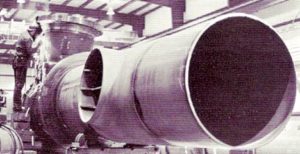Johnson Controls’ Pipeline Venture

A Johnson Controls Power and Process Piping Division employee welds a section of 48-inch diameter pipe destined for a Trans-Alaska Pipeline pumping station
Johnson Controls’ pipes help move oil through the Trans-Alaska Pipeline
July 22, 1977 (PD: 201711)
On July 22, 1977, the first barrel of oil from Alaska’s Prudhoe Bay completed its 800-mile journey through the Trans-Alaska Pipeline to the Valdez Marine Terminal (where the oil is stored for shipment by tanker).
To help keep the oil moving through the Pipeline, 11 pumping stations were built. Each of the stations had a capacity of at least 20,000 gallons per minute, while two of them could move as much as 60,000 gallons per minute.
Johnson Controls’ Power and Process Piping Division had the subcontract from Fluor Corp. to furnish the piping systems for the entire Pipeline’s pumping stations. Johnson Controls entered the industrial piping business in 1966 with its acquisitions of the Associated Piping and Engineering Company of Compton, California, and the Western Piping and Engineering Company of Los Angeles.
In 1987, the company sold the Piping Division to Smock McGhee Company, Inc. of Chicago. As for the Pipeline, at its peak in 1988 it carried two million barrels of oil a day, but by 2008, as oil production from northern Alaska’s oil fields fell, the Pipeline was carrying only 700,000 barrels a day. As a result, only five pumping stations were still in operation.
The Trans-Alaska Pipeline, constructed from 1974 to 1977 at a cost of $8 billion, is privately owned by the Alyeska Pipeline Service Company, a consortium of several oil company giants. As of 2010, the Pipeline has shipped almost 16 billion barrels of oil.

